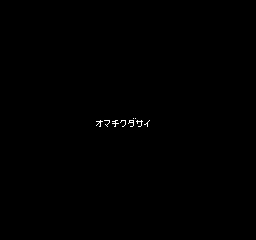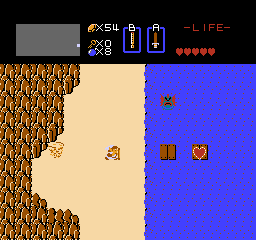The Legend of Zelda/Console Differences
This is a sub-page of The Legend of Zelda.
| To do: Moving this to "Version Differences" would work better. |
Contents
- 1 Original Release
- 1.1 Title Screen
- 1.2 Prologue
- 1.3 Erase File and Font
- 1.4 Loading Screen
- 1.5 Text
- 1.6 Game Over / Save Option Menu
- 1.7 Zora
- 1.8 Pols Voice
- 1.9 Screen Transitions
- 1.10 Map Changes
- 1.11 Memory Corruption Glitch
- 1.12 Ending
- 1.13 Audio
- 1.13.1 Music
- 1.13.2 Sound Effects
- 1.13.2.1 Boss Noise
- 1.13.2.2 Boss / Mini-Boss Get Hit
- 1.13.2.3 Door Opening and Closing
- 1.13.2.4 Item Appears
- 1.13.2.5 Link's Sword Beam
- 1.13.2.6 Flute
- 1.13.2.7 Enemy Killed
- 1.13.2.8 Rupee Pick Up
- 1.13.2.9 Item Got
- 1.13.2.10 Link Hurt
- 1.13.2.11 Link's Death
- 1.13.2.12 Bombs Detonate
- 1.13.2.13 Picking Up Hearts and Keys
- 1.13.2.14 Moving the Cursor on Game Over Screen
- 2 Revisional Differences
Original Release
There were a few changes between the Famicom Disk System, Nintendo Entertainment System, and Famicom cartridge versions of the game.
Title Screen
| FDS | NES | Famicom |
|---|---|---|
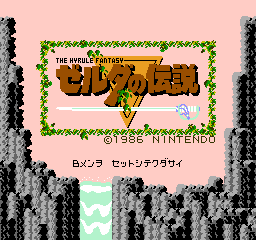
|
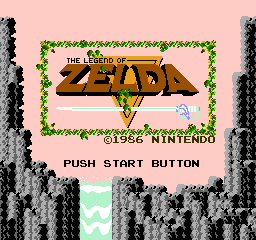
|
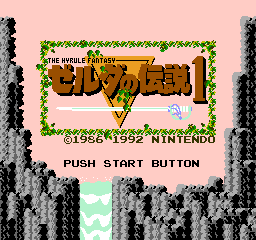
|
The original Japanese title is The Hyrule Fantasy: The Legend of Zelda. The NES version removed "The Hyrule Fantasy" from the title, and "The Legend of" took its place; the Disk Side B message was replaced with "Push Start Button".
The Japanese re-release on cartridge changed the title to The Hyrule Fantasy: The Legend of Zelda 1, with the graphics repositioned (the leaves being the only parts left unchanged aside from one due to the longer copyright text) to accommodate for the longer title. In the process they messed up the shape of the Triforce in the area below the sword, and the sword itself became a bit shorter. Additionally, the tail of the stylized "ダ" character was shortened, presumably for saving graphics space when tiles for the "1" were added. The copyright information was updated (though it strangely reads 1992 instead of 1994, implying the re-release was delayed quite a bit and possibly was originally going to release around the same time as Super Mario USA), and again the Disk Side B message was replaced with "Push Start Button".
Prologue
| FDS | NES / Famicom |
|---|---|
The title of the story was changed from "Legend of Zelda" to "The Legend of Zelda". However, the foliage next to the title wasn't updated to accommodate for this change.
| FDS | NES | Famicom |
|---|---|---|
The item originally known as the "Bible" in the FDS version was renamed to "Book of Magic" in the NES version. The Japanese re-release on cartridge and the Game & Watch: The Legend of Zelda release of the FDS version both retain this change, but the katakana text still says "Bible". In addition, the English text for all the items is blue instead of white in the Japanese versions to more easily distinguish the languages from each other.
| FDS | NES / Famicom |
|---|---|
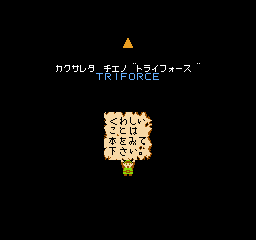 |
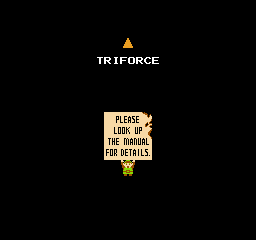 |
The sign or sheet of paper Link is holding was slightly modified when the English text was added, and the spacing between text and the Triforce was also reduced.
Erase File and Font
| FDS | NES |
|---|---|
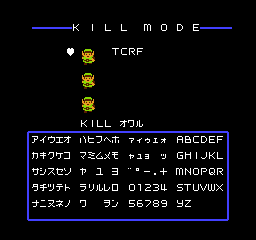 |
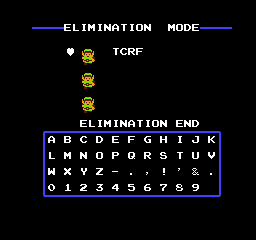 |
For the NES release of the game, Kill Mode was renamed to Elimination Mode.
| FDS | NES / Famicom |
|---|---|
The letter and number characters of the FDS version were changed from a thinner, unique font to the standard 8x8 video game font first seen in Atari's 1976 arcade game Quiz Show. Interestingly, various early screenshots of the FDS version showcase the game using the cartridge versions' font (though with minor differences). These characters got the same treatment as the NES version in the Japanese re-release as well.
Loading Screen
When you change disk sides or save your progress in the FDS version, a loading message appears in katakana text, translated to "Please Wait".
Text
| FDS / Famicom | NES |
|---|---|
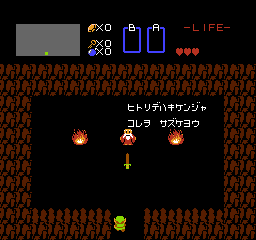 |
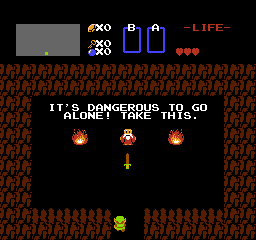 |
All the dialogue text appears right-aligned and starts right above the characters heads in the Japanese versions, sort of like a speech bubble in a comic (only without the bubble). In the NES version, the text appears centered for the most part of the game due to space constraints. The space between rows was also changed in order to fit three rows of text instead of two.
Additionally, some of the hints were changed rather than translated for the English localization. The severe Engrish and odd reasoning behind some of the changes makes it unclear what Nintendo had in mind for some of the choices made.
Level 1
| FDS / Famicom | NES |
|---|---|
| オカネガナクナレバ ヤ ハ ツカエナイ |
EASTMOST PENNINSULA IS THE SECRET. |
Literal translation: "You can't use arrows if you run out of money."
The hint in the Japanese version is a useful tip on how the Bow works, which you get in this dungeon. In the English version, it was changed to a hint for a secret 100 Rupee location.
Level 5
| FDS / Famicom | NES |
|---|---|
| オトニヨワイ イキモノ ガイル |
SECRET POWER IS SAID TO BE IN THE ARROW. |
Literal translation: "There are some creatures that are weak against sound."
The hint in the Japanese version refers to the Pols Voice's weakness. Since the NES controller doesn't have a built-in microphone like the Famicom's second controller, the method to defeat Pols Voice was changed and the different advice reflects this.
Level 7
| FDS / Famicom | NES |
|---|---|
| メガネイワ ハ シヘノ イリグチ |
THERE'S A SECRET IN THE TIP OF THE NOSE. |
Literal translation: "Spectacle Rock is an entrance to death."
The hint for how to find Level 9 was for some reason moved to Level 8 (see below). "The tip of the nose" is apparently the room in Level 7 where a secret path to the boss' lair is found. A very odd choice...
Level 8
| FDS / Famicom | NES |
|---|---|
| デスマウンテンデ ヤヲ サガセ |
SPECTACLE ROCK IS AN ENTRANCE TO DEATH. |
Literal translation: "Look for the arrows in Death Mountain."
The English version's hint was moved from Level 7 and in the process replaced the hint for where to find the Silver Arrows. What?!
| FDS / Famicom | NES |
|---|---|
| ライオンノカギヲサガセ | 10TH ENEMY HAS THE BOMB. |
Literal translation: "Search for the Lion Key."
The hint that you should look for the Magical Key in Level 8 (aka Lion) was replaced with... not the most helpful of hints.
The English line may be an attempt to hint that if you defeat ten enemies without getting hit and defeat the 10th one with a bomb, said enemy will drop a set of four bombs. If you defeat the 10th enemy with the sword, it will give you a blue Rupee instead. This video goes more in depth about the meaning of the new English line.
Level 9
| FDS / Famicom | NES |
|---|---|
| アカイユビワヲ ミツケ タカイ |
EYES OF SKULL HAS A SECRET. |
Literal translation: "Have you found the Red Ring?"
The reminder that you should probably find the Red Ring was changed to a hint for how to find the Compass.
| FDS / Famicom | NES |
|---|---|
| イチバンウエ ノ サカ イメヲ コワセ |
PATRA HAS THE MAP. |
Literal translation: "Destroy the topmost boundary."
The Japanese line may be a hint for how to find the Red Ring, but it's really vague and could as well refer to something else. Maybe that's the reason it was ultimately replaced in the English version?
What's odd is that this hint was already in place in the prototype version of the game, where all the items in Level 9 were still in different locations.
Level 6, Second Quest
| FDS / Famicom | NES |
|---|---|
| ミズウミノ キタ ニハ ヒミツガ アル |
SOUTH OF ARROW MARK HIDES A SECRET. |
Literal translation: "There’s a secret north of a lake."
Another really vague hint in the Japanese original that was replaced with something that made more sense - in this case, a hint for finding Level 8.
Game Over / Save Option Menu
| FDS | NES | Famicom |
|---|---|---|
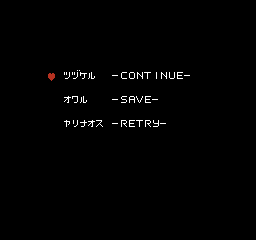
|
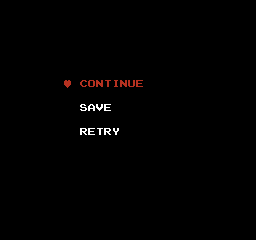
|
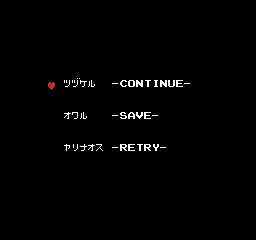
|
The Game Over / Save Option menu was slightly re-positioned for the NES version and yet again for the Japanese re-release where the options are spaced further apart.
The cartridge versions' text flashes when you select something. This does not happen in the FDS version.
Zora
| FDS | NES / Famicom |
|---|---|
A black outline was added around the Zora sprite to make it more visible. The eyes and mouth were also redrawn.
Pols Voice
![]()
In both the original FDS version and the Japanese re-release on cartridge, Pols Voice is invulnerable to arrows, but instead they're extra-vulnerable to the Famicom's built-in microphone feature. As the NES' hardware (in both the original 1985 release and 1993 redesign) lacked this feature, it was instead given a weakness to arrows. Besides their unique weakness between versions, they can also be defeated the hard way with the sword in all versions of the game.
It's worth noting that support for the Famicom microphone was removed in the NES version, however the Famicom cartridge version retains the functionality.
Screen Transitions
| FDS / NES | Famicom |
|---|---|
 |
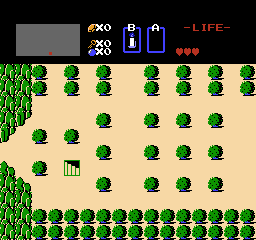 |
When you enter or exit a cave in the FDS and NES versions, the HUD will blink and Link can briefly be seen at the bottom edge of the screen. Both issues were fixed in the Famicom re-release.
Map Changes
Two dungeon rooms in the game have additional enemies in the NES and Famicom versions.
| FDS | NES / Famicom |
|---|---|
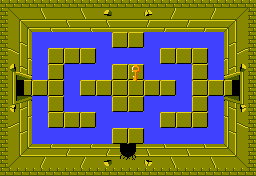 |
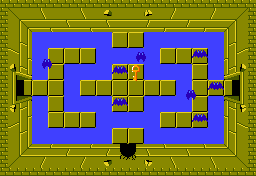 |
Eight Keese were added to this otherwise-empty room of Level 4 (First Quest).
| FDS | NES / Famicom |
|---|---|
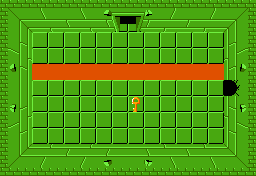 |
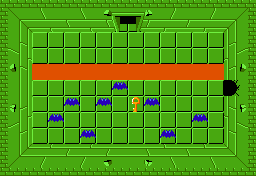 |
And again, there are eight Keese added to this room of Level 5 (First Quest).
Memory Corruption Glitch
Because hidden staircases in the game are considered sprites, the game reserves one sprite slot on all screens where hidden staircases can appear to prevent sprite overload. However, there's one instance where the programmers forgot: on the Second Quest, there's a hidden staircase in the graveyard that appears when you play the Flute. Spawning enough Ghinis from the nearby graves to reach the sprite limit then playing the Flute to spawn the hidden staircase corrupts the game's memory and leads to arbitrary code execution.
This oversight was fixed in the NES version. It does carry over to all rereleases of the FDS version, such as the emulated version contained in the Japanese The Legend of Zelda: Collector's Edition.
Ending
| FDS | NES |
|---|---|
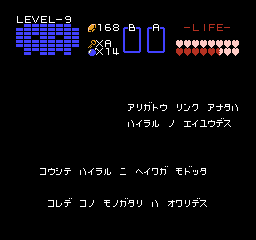 |
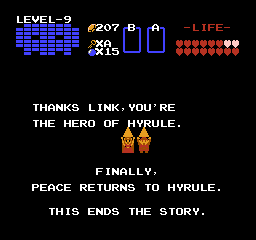 |
In the FDS version, after Zelda thanks Link, they hold up the Triforces of Power and Wisdom, and the frame starts to flash; they both disappear just before the rest of the text starts to appear under them. In the NES version, they don't disappear until the frame starts to scroll to reveal the staff credits.
Other differences:
- The FDS version has short loading times when you start the game or whenever you enter or walk out of a dungeon.
- There is far less slowdown in the FDS version compared to the NES and Famicom.
Audio
Music
The compositions are often much richer in the FDS version, due to the use of the system's wavetable sound channel.
Title Theme
| FDS | NES / Famicom |
|---|---|
Fanfare for Treasure
| FDS | NES / Famicom |
|---|---|
Secret Discovery / Puzzle Solve Chime
| FDS | NES / Famicom |
|---|---|
In the FDS version, the secret discovery chime doesn't play when pushing blocks that open doors in dungeons, though this oddly wasn't the case in the prototype. This was changed for the cartridge versions.
Game Over
| FDS | NES / Famicom |
|---|---|
For some reason, moving the cursor on the Game Over screen in the FDS version resets the musical loop. This was corrected in the NES and Famicom versions.
Level 9 (Death Mountain)
| FDS | NES / Famicom |
|---|---|
The FDS version has more bass beats before the rest of the tune begins. In the NES and Famicom versions, it proceeds straight into the melody, which effectively makes the musical loop more seamless.
Ending Theme
| FDS | NES / Famicom |
|---|---|
Sound Effects
The FDS version utilizes the system's wavetable sound channel for many sound effects as well. Some of the FDS version's sounds were later used in Super Mario Maker 2 in various scenarios when playing as Link.
Boss Noise
| FDS | NES / Famicom |
|---|---|
| FDS | NES / Famicom |
|---|---|
| FDS | NES / Famicom |
|---|---|
The sound the bosses make that is heard whenever you are close or inside their rooms.
Boss / Mini-Boss Get Hit
| FDS | NES / Famicom |
|---|---|
Door Opening and Closing
| FDS | NES / Famicom |
|---|---|
Item Appears
| FDS | NES / Famicom |
|---|---|
The sound for items that appear after clearing a room of enemies.
Link's Sword Beam
| FDS | NES / Famicom |
|---|---|
Flute
| FDS | NES / Famicom |
|---|---|
Enemy Killed
| FDS | NES / Famicom |
|---|---|
In the FDS version, this sound plays (on the FDS-only PWM channel) along with the enemy hit sound (on the other channels) when the enemy is killed. The cart versions only play the death sound effect when the enemy is killed.
Rupee Pick Up
| FDS | NES / Famicom |
|---|---|
This is also heard when moving the cursor on the File Select and Inventory screens.
Item Got
| FDS | NES / Famicom |
|---|---|
Link Hurt
| FDS | NES / Famicom |
|---|---|
Also heard when deleting a saved game file.
Link's Death
| FDS | NES / Famicom |
|---|---|
When Link dies, there's more of a series of sound effects in the FDS version as opposed to the little theme that is heard in the NES and Famicom version.
Bombs Detonate
| FDS | NES / Famicom |
|---|---|
Picking Up Hearts and Keys
| FDS | NES / Famicom |
|---|---|
Moving the Cursor on Game Over Screen
| FDS | NES / Famicom |
|---|---|
The FDS version uses the same sound for moving the cursor as in all the other menus in the game. The cart versions changed it for this particular screen to the same sound effect as when a projectile hits Link's shield.
Revisional Differences
| To do: Other differences? |
Heart Container Glitch
In the original FDS release (Rev 0), there is a glitch that allows players to easily get a lot of extra Heart Containers: on the eastern shoreline, there's a Heart Container that is normally only reachable with the Ladder. However, if you use the Flute while standing in the same row as it you'll pick up the Heart Container when the whirlwind drags you across the screen, and the Heart Container will still be there when you return.
The glitch occurs because the current room index ($00EB) is changed once you get caught by the whirlwind, setting it to the room to the left of the dungeon entrance that you spawn at. This variable is checked to determine which collect flag to set when obtaining the main room item. As such, the heart piece can be obtained only once per Flute destination for a total of 8 "duplicated" hearts, plus one more for obtaining the Heart Container normally. The number of Heart Containers will still max out at 16, and you can't get any more than that. This trick is perhaps most effective in the much harder Second Quest, where you obtain the Flute in Level 2. Using this trick makes the Second Quest much easier, not only because of increased life, but the quicker you increase the number of hearts you have, the quicker you can obtain the stronger swords.
This glitch was partially fixed in Rev 1 by making it impossible to collect the Heart Piece while being swept up by the whirlwind, but since the ($00EB) address is still being overwritten too early, it will cause a "phantom" Heart Container to appear when caught by the whirlwind. The glitch was finally fixed in later releases by storing the room index set by the whirlwind at ($00EA) instead.
Title Screen
| Revision 0 | Revision 1 |
|---|---|
 |
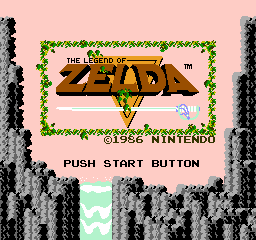 |
NES Revision 1 adds a trademark symbol to the title screen.
Save Option Screen
| Revision 0 | Revision 1 | Animal Crossing |
|---|---|---|

|
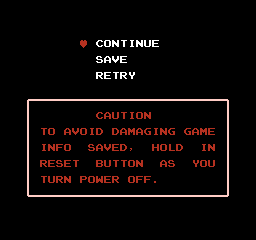
|
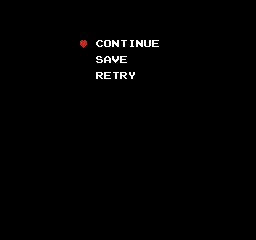
|
NES Revision 1 adds a small warning to the Continue/Save/Retry screen. The elusive Animal Crossing version of the game keeps this screen layout but removes the warning, as it's unnecessary on the GameCube. It's worth noting that The Legend of Zelda is the only game that is completely unobtainable in Animal Crossing without a game enhancer such as Action Replay.
Some Virtual Console versions use this screen layout as well.
2003 Version
The game was re-released for the GameCube in 2003, the Game Boy Advance in 2004, the Wii Virtual Console in 2007, and the Wii U Virtual Console in 2013. The emulations are all altered with a new translation, in an attempt to reduce the amount of Engrish. This altered version of the game, oddly enough, didn't make the cut when the game was released on the Nintendo 3DS, which instead uses a modified US Revision 1.
Story
| Famicom / NES | 2003 Version |
|---|---|
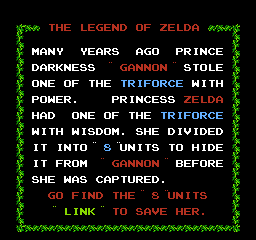 |
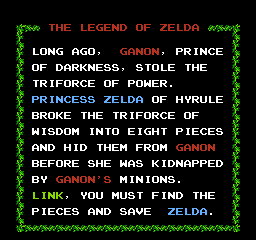 |
In addition to cleaning up the severe Engrish in the original release, the quotation marks were scrapped and the color coding was altered. Whereas the original put emphasis on the Triforce and its eight pieces by using blue and Link's quest by using red, the updated version instead went with a blue color for Zelda.
| Famicom / NES | 2003 Version |
|---|---|
MANY YEARS AGO PRINCE DARKNESS " GANNON" STOLE ONE OF THE TRIFORCE WITH POWER. PRINCESS ZELDA HAD ONE OF THE TRIFORCE WITH WISDOM. SHE DIVIDED IT INTO" 8"UNITS TO HIDE IT FROM " GANNON" BEFORE SHE WAS CAPTURED. GO FIND THE " 8"UNITS " LINK" TO SAVE HER. |
LONG AGO, GANON, PRINCE OF DARKNESS, STOLE THE TRIFORCE OF POWER. PRINCESS ZELDA OF HYRULE BROKE THE TRIFORCE OF WISDOM INTO EIGHT PIECES AND HID THEM FROM GANON BEFORE SHE WAS KIDNAPPED BY GANON'S MINIONS. LINK, YOU MUST FIND THE PIECES AND SAVE ZELDA. |
Treasures
Additional Engrish fix-up in the treasure listing.
| Famicom / NES | 2003 Version |
|---|---|
| ALL OF TREASURES | ALL TREASURES |
| Famicom / NES | 2003 Version |
|---|---|
| RUPY | RUPEE |
| Famicom / NES | 2003 Version |
|---|---|
| 5 RUPIES | 5 RUPEES |
Dialogue
A few lines of text were (somewhat) corrected as well.
| NES | 2003 Version |
|---|---|
| LET'S PLAY MONEY MAKING GAME. |
LET'S PLAY A MONEY-MAKING GAME. |
| NES | 2003 Version |
|---|---|
| SECRET IS IN THE TREE AT THE DEAD-END. |
A SECRET IS IN THE TREE AT THE DEAD-END. |
| NES | 2003 Version |
|---|---|
| PAY ME FOR THE DOOR REPAIR CHARGE. |
PAY ME FOR THE DOOR REPAIR. |
| NES | 2003 Version |
|---|---|
| DIGDOGGER HATES CERTAIN KIND OF SOUND. |
DIGDOGGER HATES CERTAIN KINDS OF SOUND. |
| NES | 2003 Version |
|---|---|
| SECRET POWER IS SAID TO BE IN THE ARROW. |
A SECRET POWER IS SAID TO BE IN THE ARROW. |
| NES | 2003 Version |
|---|---|
| ONES WHO DOES NOT HAVE TRIFORCE CAN'T GO IN. |
ONES WHO DO NOT HAVE TRIFORCE CAN'T ENTER. |
| NES | 2003 Version |
|---|---|
| EYES OF SKULL HAS A SECRET. |
THE EYES OF THE SKULL HAVE SECRETS. |
| NES | 2003 Version |
|---|---|
| SOUTH OF ARROW MARK HIDES A SECRET. |
SOUTH OF THE ARROW MARK HIDES A SECRET. |
| NES | 2003 Version |
|---|---|
| FINALLY, PEACE RETURNS TO HYRULE. THIS ENDS THE STORY. |
FINALLY, PEACE RETURNS TO HYRULE. THE END. |
| NES | 2003 Version |
|---|---|
| YOU ARE GREAT. YOU HAVE AN AMAZING WISDOM AND POWER. ©1986 NINTENDO |
YOU ARE GREAT! YOU HAVE AN AMAZING WISDOM AND POWER! NINTENDO |
Screen Flashing
When you pick up the Triforce and the fragments in the original version, the screen flashes rapidly. In the updated versions, it was greatly reduced to prevent seizures.
PAUSE Text
In the GBA and GameCube versions, when the game is paused, a small, black box that says "PAUSE" appears. This does not occur in the FDS, NES, or Famicom versions.
Japanese Re-release
The game was also re-released in Japan on GameCube in 2004, and later on the Game Boy Advance, Wii Virtual Console, and Wii U Virtual Console. The Japanese re-release is based on the FDS version with the rewritten intro from the international re-release, along with an updated 2004 copyright. The Japanese 3DS VC version, similarly to the international 3DS version, opted to use the Famicom cartridge version instead of the 2004 one.
| FDS | Wii Virtual Console |
|---|---|
 |
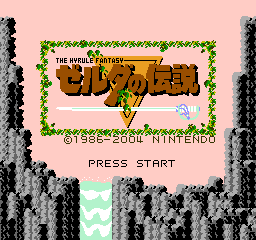 |
It is a near-identical emulation of the original FDS version, but at least one weird audio glitch can be heard in the dungeons: namely, the sound the bosses make that is heard whenever you are close or inside the lair has the same volume no matter if you are outside or inside their rooms. In the FDS version, the volume was a bit lower when you were outside the boss room.
Other
A modified (read: glorified ROM hack/savestate) version titled The Legend of Zelda SP (Special) (also known as The Legend of Zelda: Living the life of luxury!) was released for the Nintendo Switch's NES game collection, available to users of the Switch Online subscription service. It gives the player 255 Rupees, 9 keys, 8 bombs, three additional Heart Containers and all equipment from the start, though Bomb upgrades, Book of Magic, Boomerang, Bow, Letter, Magical Rod, Magical Boomerang, Magical Key, Magical Sword, Raft, Whistle, Red Candle, Red Ring, Ladder and the Silver Arrows still need to be obtained during the game.
